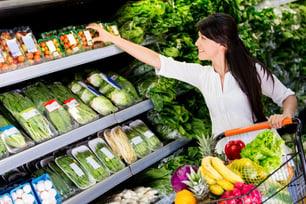 Merchants can have a positive impact on the customer checkout experience by providing quick service, implementing a simple interface, offering a variety of payment options and more. In a unique environment like grocery, fulfilling these needs can be challenging - but the most logical way to elevate the commerce experience is to have a complete understanding of current retail trends and how they can help grocers create loyal customers.
Merchants can have a positive impact on the customer checkout experience by providing quick service, implementing a simple interface, offering a variety of payment options and more. In a unique environment like grocery, fulfilling these needs can be challenging - but the most logical way to elevate the commerce experience is to have a complete understanding of current retail trends and how they can help grocers create loyal customers.
Focusing on customer needs and desires in a grocery store can aid a merchant’s decision on the best approach to payments. The following trends are critical factors in ensuring a pleasant and effortless checkout experience for customers:
A Unified Customer Experience
A common source of frustration for customers is the frequent disconnect across channels when engaging with a grocer. When there is an inconsistency between online shopping and in-person, both the merchant and the customer can suffer a loss in some way. For example, if a customer utilizes a Buy Online Pickup in Store (BOPIS) service, they expect the merchant to be able to access or modify the details of that order to add their loyalty information or accommodate any changes. If the merchant can’t provide these services, this can create a negative experience for the customer and potential loss of business for the merchant. A unified strategy allowing online and in-store to work seamlessly could fix this problem and create consistency across channels to guarantee an identical experience. This strategy could include measures like managing inventory and pricing across channels to make sure they are consistent and customers can but what they are looking for.
Business Intelligence
Data and business intelligence play an increasingly important role in retail as merchants build loyalty with their customers. By collecting data that shows which products are being purchased consistently by a consumer, grocery stores can use this information to better plan their operations and engage with customers on a more personal level. As a grocer, this data can help you manage your inventory better – when to restock, contingencies for busy times during the year, etc. It can also assist your business to utilize the physical space in the best way possible. Data & business intelligence helps grocers refine their selling strategies.
Moving on to engaging with customers, according to a recent Emerging Trends study by Hanover Research, 75 percent of consumers want rewards for everything and 70 percent want to apply rewards directly to purchases. When merchants are given more information about their customers, they are better suited to know them and their preferences. They are better positioned to provide meaningful rewards and serve them in the best way possible. This includes providing loyalty points for frequent purchases, or simply ensuring certain items that customers are regularly purchasing are kept in-stock.
Modular Mobility
Payment at the point of decision is a consistent luxury of shopping online, and it’s quickly becoming a convenience that customers expect to find when in a store. Frustration and confusion arise when a customer chooses an item in a store and is directed to a different location to pay. For example, if a customer interacts with an employee to order a cake in the bakery and is then directed to the checkout lanes to complete their transaction, this adds unnecessary steps to the process. With mobile POS technology, employees can instead take customer orders on the spot, making them more productive. These solutions make for smooth and quick customer experience.
Self-Service
To ensure customers feel they are in control of their shopping experience, merchants can offer options that allow them to shop and pay the way they want. Self-service can be used at multiple steps of the customer journey. Traditional self-checkout has been part of grocery for quite some time, but the past few years have brought more advanced ways of putting the payments entirely in the hands of the consumers. Some grocery stores enable customers to shop with a handheld device that scans each item as they place it in the cart. At the end of the shopping trip, customers simply pay using this device or a kiosk in the store for a completely seamless experience. Self-service provides the option for customers to skip long checkout lines entirely and take control of their experience. This technology also brings benefits to the merchant, allowing them to reallocate resources more efficiently.
With an understanding of retail trends and the way consumers prefer to shop and pay, grocers can utilize new payment technology to enhance the shopping experience for everyone. This is particularly true with some of the trends making headway in the retail industry: a unified strategy including all channels, business intelligence, modular mobility and self-service.
Get in touch with us to learn more about strategies that can enhance the commerce experience in your grocery store and help you to maintain strong relationships with your customers.
Peter Charpentier is Senior Director of Product Marketing, Ingenico Group, North America










